How to Remove Cloudiness From a Glass Top Stove
Author: Anne Cowart | Editor: Omar Alonso
Review & Research: Jen Worst & Chris Miller

Did you just install a sleek and shiny glass stovetop in your kitchen? It's a great way to update your kitchen aesthetic to a modern look. The problem with glass top stoves is that they tend to build up grime, accumulate scratches, and develop a cloudy white haze as time passes. This is how to remove cloudiness from a glass top stove.
Hard water deposits, acidic condensates, and other harmful materials can leave your shiny new glass stovetop looking dreadful after a few months. Never fear. We have the solution to restoring and maintaining any glass-top stove. Are you ready? Let’s dive in!
How to Remove Cloudiness From a Glass Top Stove in 6 Steps
If your glass stovetop is looking worse for wear, follow this guide to get it looking great. And don't worry, everyone with these types of stoves deals with these issues. All it takes is a few basic household products and some power scrubbing, and you'll have to looking good as new.
1) Apply Dish Soap to the Affected Area
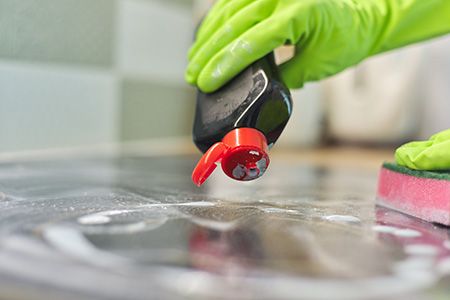
You don't need fancy cleaners or specialized tools to get your glass-top stove into tip-top condition. If the surface looks cloudy, follow this process, and it's sparkling clean in no time. The first step is to ensure the stovetop is cool.
We recommend only using our process before cooking on the stovetop. Don't think you can wait 30 minutes after cooking and do it when it's lukewarm. You won't get the same results. Trying this method on a hot stovetop will only exacerbate the problem.
Pour some concentrated dish soap, any brand, around the burners and the edges of the stovetop. Leave the dish soap to work on the stains while you grab the baking soda. You don't need to leave it to work on the white haze on the glass cooktop. Just move to the next step.
2) Add Baking Soda to the Dish Soap
Next, sprinkle some baking soda over the dish soap. Baking soda has an effervescent property, enhancing the cleaning power of your dish soap application. Sodium bicarbonate absorbs odors and breaks down grease and grime.
Combining baking soda with dish soap also creates a powerful household cleaning agent. Mix the two together, and you'll see a paste starting to form. After you have the paste going, work it into the stovetop and the edges. Leave it to do its thing for a few minutes before moving on to the next step. It will start working on your black glass top stove discoloration immediately.
3) Spray a Citrus Cleaner & Hot Water
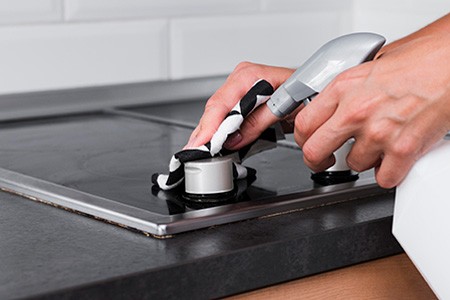
Give the baking soda and dish soap around five to ten minutes to lift the tough stains from the glass stovetop. While you wait, mix up some citric acid-based all-purpose kitchen cleaner with a cup of hot water. You don't need to add much cleaner; around 15ml is sufficient (half a shot glass).
Pour the mixture into a spray bottle and spray it over the dish soap and baking soda combination. The acidic nature of the citrus cleaner is like using vinegar on tough stains. After covering the affected area, leave it to steep in the other ingredients for five minutes.
4) Scrub With a Sponge
The combination of citric cleaner and baking soda starts a reaction where you see it bubbling. Don't worry; it won't explode or melt through the glass top. This reaction occurs due to carbon dioxide production from the combined ingredients.
It's a similar effect to the volcano experiment you did as a kid in science class. It's also the same effect produced by a bath bomb when you add it to water. Walk away and read a book, work in the garden, or watch TV for 30 to 45 minutes to give the combination time to work.
After times up, return to the stove and scrub out the stains using a sponge. You'll find the parts of your black glass stove top turning white will be cleared up, if not vastly improved. Add another application if you wish and wait again. When satisfied with the reduced glass stove top discoloration, move to the next step.
5) Wipe It Down Using a Microfiber Cloth
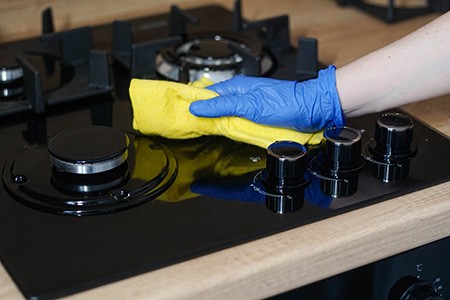
After removing all the grease and grime from the stovetop, wipe away the cleaner and excess with a damp microfiber cloth. Rinse and wring the cloth out and repeat until you have a clean surface with no traces of cleaning agents.
6) Dry Off the Stovetop
Finally, dry off the glass stovetop using a lint-free microfiber cloth. Polish up the glass to a shine, and you'll notice all the white spots around the burners are gone, and the corners are grime-free. And that's how to remove cloudiness from a glass top stove!
Finish the Job With Polishing Powder & a Razor Blade
If you have baked-in grease or grime on your glass stovetop, the above method might need a helping hand to eliminate all the additional caked deposits.
If that is the case, run through steps one to four. Before you use the sponge to scrub away the stains, get your razor blade tool. This tool is the secret weapon for removing stubborn deposits on the stovetop.
Don't freak out; it's not as challenging or dangerous as you think. Home appliance stores sell a tool that looks like a long, flat steel handle with a head at the front for mounting a razor blade. The handle makes it possible to use the razor blade without hurting yourself.
Place the razor blade on the surface of the glass top stove at a 45-degree angle and push it forward, don't scrap it backward. The motion of the blade forces the sharp edge under the baked-in stains. Since the cleaning products loosen the dirt, the razor blade should easily lift it from the surface.
Some manufacturing brands recommend avoiding this tool as it might scrape away paint markings on the stovetop surface, indicating the area for the burners and the temperature of the cooking surface. Check your owner's manual to see if it's approved or not.
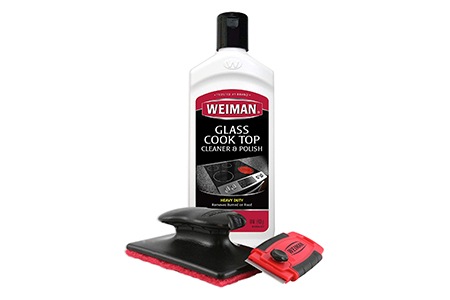
We recommend finishing the job with specialized polishing powder to remove any remaining cloudiness on the stovetop. Each manufacturer sells this powder or liquid and you can find generic versions in your local grocery store, too.
What To Avoid When Cleaning Glass Stovetops
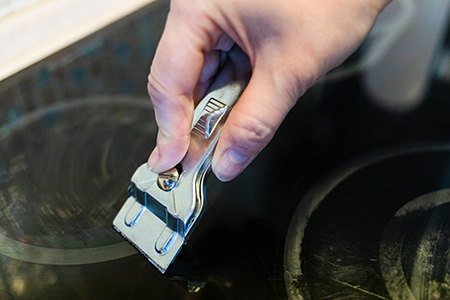
Cleaning the stovetop is essential to keep it looking great and to prevent the buildup of grease and grime that present a health risk to your family. While it's an important task, there are a few things you need to know to prevent turning the job into a nightmare.
Don't Apply Too Much Pressure
When scrubbing the stovetop with the sponge or using the scraper, ensure you don't apply too much pressure. The glass on the stovetop is hardened, but it isn't bulletproof. If you place too much weight on it, you'll crack the surface and end up kicking yourself for being an idiot. If the stain isn't going away, add cleaner, not more pressure.
Avoid Caustic Cleaning Products
Don't use caustic cleaning products like bleach on the stovetop. If you heat up excess bleach on the stovetop surface, you'll cause a chemical reaction forming deadly chlorine gas. But don't worry about hot water and the myth that you can't mix bleach with it. It's not true because the water isn't hot enough to create dangerous chemicals or render the bleach ineffective.
Also, combining bleach with vinegar will create chlorine gas, so avoid using bleach or ammonia-based cleaner on the stovetop. Stick to the natural stuff; it works. If you must, you can safely mix bleach and baking soda.
Don't Use Scourers or Steel Wool
Avoid using aggressive cleaning instruments on the glass top. When scrubbing with the sponge, don't use the scouring pad on the other side to remove stubborn stains. You'll scratch the galls and leave it looking terrible.
Likewise, avoid using steel wool to remove stains. You'll scratch the surface and hate yourself for doing it. The sponge and razor blade are all you need to get excellent results.
Tips for Keeping Your Glass Top Stove Looking Like New
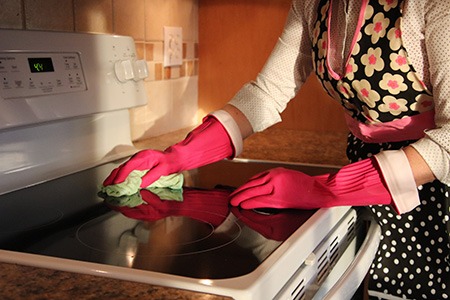
There’s a handful of easy tasks you can do (think of them as regular chores) that will keep your glass stovetop looking like the day you bought it. And worse case scenario, it makes cleaning the glass stovetop so much easier when you need to.
Clean the Glass Stovetop After Each Use
Keep the glass stovetop looking great by cleaning it after each use. After you complete the deep cleaning process outlined above, conduct daily preventative maintenance on the stovetop after each use. Wait until the stove cools, and use a gentle all-purpose citrus-based cleaner to clean the stovetop.
Enjoy your dinner, return to the stove, spray the cleaner and do the dishes. Give the spray a few minutes to soak in, and wipe it away with a microfiber cloth and a sponge. Doing this daily prevents the buildup of grit and grime.
Clean the Bottom of Your Cookware
The cooking surface isn't the only problem. Your cookware needs regular cleaning as well. It's common for the bottom of all your types of pans and even pots to experience a buildup of grease and grime. Overflowing water and oils landing on the hot surface of the stovetop boils, hardening into the blackened grit and grime.
This transfers to the underside of your pots and pans and keeps a vicious cycle where everything stays dirty. Cleaning the pots and pans once a month during your deep cleaning process is the best way to keep them clean and avoid buildup on the stovetop.
Deep Clean the Stovetop Monthly
Even if you clean the stove daily, you're likely to miss a day here or there. Or you might fail to get all the grease and grime off the stovetop. Eventually, it builds up, and you're back to where too were at the beginning of the article. To ensure the best results with maintaining your glass stovetop, give it a monthly deep clean using the described method.
That's How to Remove Cloudiness From a Glass Top Stove
Follow the tips in this post to remove any deposits or cloudy marks on your glass stovetop. You'll find the results amazing. Keep up with preventative maintenance, and your glass stovetop will always look new. And that's how to remove cloudiness from a glass top stove!




